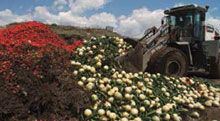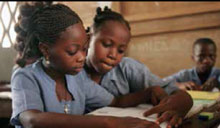In Brief
Finance & Development, March 2014, Vol. 51, No. 1
Feeding 9 billion by 2050

The world’s agricultural production must shift to more sustainable patterns—including greater respect for ecosystem services and less waste—in order to feed the world’s rapidly increasing population by 2050, says United Nations Environment Programme (UNEP) Executive Director Achim Steiner.
Speaking at the Global Forum for Food and Agriculture organized by UNEP in mid-January, Steiner stressed that, by 2050, the Earth will likely need to feed some 9 billion people with the same amount of land, water, and natural resources it has now.
In order for increases in agricultural production to be sustainable, he added, humanity must reduce its massive loss and wastage of food, as outlined in a soon-to-be-released UNEP study, Food Wasted, Food Lost: Improving Food Security by Restoring Ecosystems and Reducing Food Loss.
Food loss occurs mostly at the production stages of harvesting, processing, and distribution, while food waste typically takes place at the retail and consumer end of the food supply chain. In industrialized regions, almost half of all food is squandered because producers, retailers, and consumers discard food that is still fit for consumption.
The quantity wasted amounts to more than the total net food production of sub-Saharan Africa and could feed the estimated 870 million hungry people in today’s world.
Time for a sea change

Major changes in how the planet’s marine resources are managed and used are needed to safeguard global food security and preserve coastal and island countries, said Food and Agriculture Organization (FAO) Director-General José Graziano da Silva at the recent Blue Economy Summit.
Serious threats to ocean health such as pollution, overfishing, altered weather, and rising sea levels resulting from climate change must be tackled in earnest starting now, he argues. In a “blue economy,” the sustainable development of oceans and fisheries is given priority.
On average, nearly 17 percent of animal protein consumed worldwide comes from fisheries and aquaculture, and in many small island developing states, the figure is much higher. At the same time, the livelihoods of 12 percent of the world’s population depend on fisheries and aquaculture.
But 30 percent of world fish stocks are estimated to be overexploited, depleted, or recovering from depletion, with economic losses in marine fisheries resulting from poor management, inefficiencies, and overfishing adding up to $50 billion a year, FAO studies show.
And now climate change is posing new challenges by modifying the distribution and productivity of marine and freshwater species, affecting biological processes and altering food webs.
As a result, the FAO is establishing the Blue Growth Initiative, which will act as a catalyst for policy development, investment, and innovation to support the management of aquatic resources.
No cause for complacency
Global efforts to control and eliminate malaria have saved an estimated 3.3 million lives since 2000, reducing malaria mortality rates by 45 percent globally and by 49 percent in Africa, according the World Malaria Report 2013, published by the World Health Organization (WHO).
Expanded prevention and control measures are reflected in a consistent decline in malaria deaths and illness, despite an increase in the global population at risk of malaria between 2000 and 2012. Increased political commitment and expanded funding have played a key role.
The majority of the 3.3 million lives saved between 2000 and 2012 were in the 10 countries with the highest malaria burden and among children under 5, the group most affected by the disease. But more needs to be done.
“This remarkable progress is no cause for complacency: absolute numbers of malaria cases and deaths are not going down as fast as they could,” said Margaret Chan, WHO Director-General. “The fact that so many people are infected and dying from mosquito bites is one of the greatest tragedies of the 21st century.”
New “school tool”

The World Bank Group has launched a new open data tool that provides in-depth, comparative, and easily accessible data on education policies around the world.
The Systems Approach for Better Education Results (SABER) Web tool helps countries collect and analyze information on their education policies, benchmark themselves against other countries, and prioritize areas for reform, with the goal of ensuring that all young people go to school and learn.
“Education is one of the most important drivers for ending extreme poverty and boosting shared prosperity. But guaranteeing a basic education means little unless schooling leads to learning for all children and youth,” said Elizabeth King, Acting Vice President for Human Development and Director of Education at the World Bank.
Despite significant progress in recent decades in getting children into school, learning levels remain alarmingly poor. In low-income countries, many young people complete basic education without acquiring fundamental literacy and numeracy skills. Even in middle-income countries, many students do not learn the basic skills expected by employers and needed to secure a job. Today, an estimated 250 million children around the world are unable to read and write, even after spending three or more years in school.
The World Bank, through SABER, has analyzed more than 100 countries to date. It plans to use the data to help countries link policy implementation to enhanced student performance and ensure that education programs have their intended outcomes.
Smart transport

Improved urban transportation strategies can bring a myriad of benefits to India, from reduced carbon emissions to a more mobile and inclusive society, a new report says.
According to Toolkits for Urban Development: Compre-hensive Mobility Plans, the goal of mobility strategies—which include more efficient vehicular traffic, enhanced public transit systems, and nonmotorized transportation—should be safe, secure, and efficient connectivity that enhances economic, social, and environmental sustainability.
Since 2008, developments in India’s policy landscape have a heightened focus on climate change. Given that growth over the past two decades has widened the chasm between the rich and poor, there is also an emerging focus on inclusive development.
The report recommends that cities develop strong, clear, and practical mobility plans. Issued by India’s Ministry of Urban Development together with the Institute of Urban Transport, UNEP, and others, the report builds on a similar study issued in 2008.
Africa’s youth need skills boost
Raising earning potential among Africa’s growing youth population is a major priority for the region that will require strong action on multiple fronts, according to a new World Bank report, Youth Employment in Sub-Saharan Africa.
With youth now making up the largest share of the population in most African countries, it is more urgent than ever to pave the way for more productive job opportunities, the report notes. This is true regardless of the type of work that young people will do—in the fast-growing modern wage sector, in household enterprises, or on millions of small family-run farms.
“All young people need to have acquired basic literacy and numeracy, without which their earning potential remains low,” said Deon Filmer, one of the authors of the report and lead economist in the World Bank’s Development Research Group and Africa Region. “They also need to be able to access land, financing, and training, all of which play an important role in improving their prospects.”
Government policies must help build human capital and improve the business environment, so that the private sector can seize opportunities that arise from inevitable changes in the competitiveness of other regions. The report emphasizes that productivity must increase in agriculture, household enterprises, and the modern wage sector so that all young people can see better prospects ahead.
With the right combination of policies in place, Africa’s position as the “youngest” region in the world—in most other regions populations are rapidly aging—could lead to greater prosperity at the household level and major economic gains for African countries.
Events in 2014
March 27–30, Costa do Suípe, Bahía, Brazil
Annual Meeting of the Inter-American Development Bank
April 11–13, Washington, D.C.
Spring Meetings of the IMF and the World Bank
May 2–5, Astana, Kazakhstan
Annual Meeting of the Asian Development Bank
May 14–15, Warsaw, Poland
Annual Meeting of the European Bank for Reconstruction and Development
May 16–17, Geneva, Switzerland
Africa Health Forum
May 29–30, Maputo, Mozambique
Africa Rising Conference
June 4–5, Sochi, Russia
Group of Eight Summit


